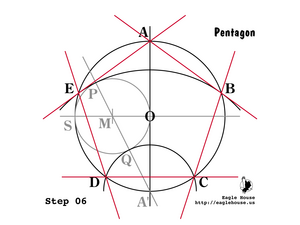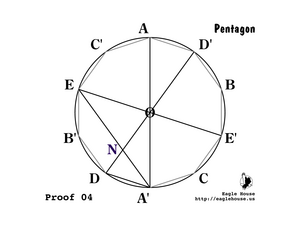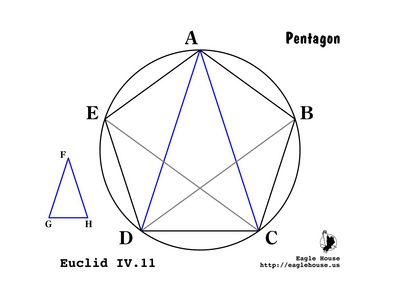Construct a pentagon/comments
Contents
Comments
Summary
Construction and proof of the inscribed pentagon is interesting for several reasons. It is much more complex than the corresponding work for other polygons of small degree; most can be constructed with little effort and proof is trivial. This proof relies heavily on the Golden Ratio, ![]() ; although we treat this in the proof as a variable and set about deriving its value, this may be considered a universal constant, much like π or e, to both of which it is related. And instead of progressing in a strictly straightforward manner, we start with a completed decagon and work down to calculated lengths; then we start with basic axioms and build up our construction to these same lengths. Analysis and synthesis meet in the middle at
; although we treat this in the proof as a variable and set about deriving its value, this may be considered a universal constant, much like π or e, to both of which it is related. And instead of progressing in a strictly straightforward manner, we start with a completed decagon and work down to calculated lengths; then we start with basic axioms and build up our construction to these same lengths. Analysis and synthesis meet in the middle at ![]() .
.
What makes the pentagon so difficult is that the angle subtending adjacent vertices is 2π / 5. The easy-to-come-by angles are π / 3, π / 6, and π / 2 (the right angle). Also, angles such as π / 4 and π / 12 are easy to derive from these. The inscribed square is constructed by finding first the right angle, then connecting corners; the inscribed hexagon is constructed of sides all equal in length to the radius. In our construction, we make no effort to find the angle of the pentagon (although we derive it in our proof); we seek instead lengths EA' and DA' -- and A' is not even a vertex of the pentagon, but only of the decagon.
Even resorting to the decagon, we run into a stumbling block when we try to calculate these lengths. In our construction, we're able to apply Pythagoras on the line SO; but S is neither a vertex of the pentagon nor the decagon. To verify our construction, our proof must determine the length of at least one line connecting vertices of the decagon -- a line that does not pass through the center point O.
We might attempt to use Pythagoras on, say, DC. Find the intersection of DC with AA'; call this T. Now if we knew the lengths of TD and TA', we could easily find DA'. But we have no way to proceed to either of these.
With only Pythagoras, we might be stopped. The Golden Ratio is our path to solution. Using the properties of similar and isosceles triangles, we discover that there are only a small number of different line lengths in the decagon and they are all related to one another through this ratio, ![]() . In the end we find that one form of
. In the end we find that one form of ![]() :
:
- {EQ 11}
is identical to the value we calculate in our construction using Pythagoras.
Decagon
Why do we use a decagon at all? Is there no way to construct and prove the construction without the use of the point A'?
There are many alternate constructions and there is indeed a common construction that makes no use of A'. The difficulty is that since none of the vertices of the pentagon lie on the line SO, Pythagoras must be used twice. The length of the side of the inscribed pentagon (given as before a radius of 1) is:
- {EQ 24}
This can be related to ![]() but again, the proof relies on vertex A' of the decagon. The algebra is messy, too.
but again, the proof relies on vertex A' of the decagon. The algebra is messy, too.
Euclid
Euclid's construction of the inscribed pentagon, (IV.11), is rather roundabout. He first constructs a Golden Triangle on an arbitrary line, then inscribes a similar triangle in the given circle. This gives elements of both pentagon and pentagram, from which the other sides of the pentagon may be constructed easily.
This approach depends on a few things we do not need with our construction: (IV.10) and (IV.2). The construction is clumsy but, in compensation, the proof is simple.



